Raman Spectroscopic Study of Five Typical Plasticizers Based on DFT and HF Theoretical Calculation
Abstract
:1. Introduction
2. Materials and Methods
2.1. Materials and Equipment
2.2. Spectral Acquisition
2.3. Theoretical Calculation
3. Results
3.1. Molecular Structure of PAEs
3.2. Experimental Raman Spectra of PAEs
3.3. Comparison of HF and DFT Methods
3.4. Different Basis Sets with DFT B3LYP
3.5. Vibration Mode Assignment of Raman Peaks
4. Conclusions
Author Contributions
Funding
Data Availability Statement
Conflicts of Interest
References
- Zhao, E.; Xu, Z.; Xiong, X.; Hu, H.; Wu, C. The impact of particle size and photoaging on the leaching of phthalates from plastic waste. J. Clean. Prod. 2022, 367, 133109. [Google Scholar] [CrossRef]
- He, L.; Gielen, G.; Bolan, N.S.; Zhang, X.; Qin, H.; Huang, H.; Wang, H. Contamination and remediation of phthalic acid esters in agricultural soils in China: A review. Agron. Sustain. Dev. 2015, 35, 519–534. [Google Scholar] [CrossRef] [Green Version]
- Li, J.H.; Ko, Y.C. Plasticizer incident and its health effects in Taiwan. Kaohsiung J. Med. Sci. 2012, 28, S17–S21. [Google Scholar] [CrossRef]
- Ruan, H.; Rong, W.; Ma, Y.; Ji, W.; Liu, H. Recent progress of detection methods for phthalate esters. Chin. J. Food Hygi 2014, 26, 193–198. [Google Scholar]
- Yu, S. Detection and toxicity analysis of plasticizer in plastic bottled vinegar. China Condiment 2019, 44, 171–175. [Google Scholar]
- Li, J.; Hu, X.; Zhou, Y.; Zhang, L.; Ge, Z.; Wang, X.; Xu, W. β-Cyclodextrin-stabilized Au nanoparticles for the detection of butyl benzyl phthalate. ACS Appl. Nano Mater. 2019, 2, 2743–2751. [Google Scholar] [CrossRef]
- Rong, Y.; Ali, S.; Ouyang, Q.; Wang, L.; Li, H.; Chen, Q. Development of a bimodal sensor based on upconversion nanoparticles and surface-enhanced Raman for the sensitive determination of dibutyl phthalate in food. J. Food Compost. Anal. 2021, 100, 103929. [Google Scholar] [CrossRef]
- Xu, S.; Li, H.; Guo, M.; Wang, L.; Li, X.; Xue, Q. Liquid-liquid interfacial self-assembled triangular Ag nanoplate-based high-density and ordered SERS-active arrays for the sensitive detection of dibutyl phthalate (DBP) in edible oils. Analyst 2021, 146, 4858–4864. [Google Scholar] [CrossRef] [PubMed]
- Wu, L.; Wang, W.; Zhang, W.; Su, H.; Liu, Q.; Gu, J.; Deng, T.; Zhang, D. Highly sensitive, reproducible and uniform SERS substrates with a high density of three-dimensionally distributed hotspots:gyroid-structured Au periodic metallic materials. NPG Asia Mater. 2018, 10, e462. [Google Scholar] [CrossRef] [Green Version]
- Zhou, Y.; Li, J.; Zhang, L.; Ge, Z.; Wang, X.; Hu, X.; Xu, T.; Li, P.; Xu, W. HS-beta-cyclodextrin-functionalized Ag@Fe3O4@Ag nanoparticles as a surface-enhanced Raman spectroscopy substrate for the sensitive detection of butyl benzyl phthalate. Anal. Bioanal. Chem. 2019, 411, 5691–5701. [Google Scholar] [CrossRef] [PubMed]
- Cao, Q.; Che, R. Tailoring Au-Ag-S composite microstructures in one-pot for both SERS detection and photocatalytic degradation of plasticizers DEHA and DEHP. ACS Appl. Mater. Interfaces 2014, 6, 7020–7027. [Google Scholar] [CrossRef] [PubMed]
- Wang, H.; Wang, C.; Huang, J.; Liu, Y.; Wu, Y.; You, R.; Zhang, J.; Lu, Y.; Shen, H. Preparation of SERS substrate with 2D silver plate and nano silver sol for plasticizer detection in edible oil. Food Chem. 2023, 409, 135363. [Google Scholar] [CrossRef] [PubMed]
- Wu, X.; Ma, R.; Xu, B.; Wang, Z.; Du, Z.; Zhang, X.; Niu, Y.; Gao, S.; Liu, H.; Zhang, Y. Qualitative and quantitative studies of plasticizers in extra virgin olive oil by surface-enhanced Raman spectroscopy combined with chemometrics. Vib. Spectrosc. 2023, 126, 103527. [Google Scholar] [CrossRef]
- Alparone, A. Density functional theory Raman spectra of cyclic selenium clusters Se-n (n = 5–12). Comput. Theor. Chem. 2012, 988, 81–85. [Google Scholar] [CrossRef]
- Arici, K.; Yilmaz, R. Infrared Spectra, Density Functional Theory and Hartree-Fock Theoretical Calculations of 2-Methyl- 8-quinolinol. Chem. Asian J. 2013, 25, 7106–7114. [Google Scholar] [CrossRef]
- Ma, Y.; Hu, W.; Song, X.; Wang, C. Density Functional theory study on Raman spectra of rhodamine molecules in different forms. Chin. J. Chem. Phys. 2014, 27, 291–296. [Google Scholar] [CrossRef] [Green Version]
- Weck, P.F.; Gordon, M.E.; Greathouse, J.A.; Bryan, C.R.; Meserole, S.P.; Rodriguez, M.A.; Payne, C.; Kim, E. Infrared and Raman spectroscopy of alpha-ZrW2O8: A comprehensive density functional perturbation theory and experimental study. J. Raman Spectrosc. 2018, 49, 1373–1384. [Google Scholar] [CrossRef]
- Zhang, Z.; Wang, W.; Liu, S.; Chen, D. Experimental and density functional theory calculation studies on Raman and infrared spectra of 1,1 ′-Binaphthyl-2,2 ′-diamine. Chin. J. Chem. Phys. 2017, 30, 7–15. [Google Scholar] [CrossRef] [Green Version]
- Ji, L.; Sun, Y.; Xie, Y.; Wang, H.; Qian, H.; Wang, L.; Yao, W. Density functional theory and surface-enhanced Raman spectroscopy studies on endocrine-disrupting chemical, dimethyl phthalate. Vib. Spectrosc. 2015, 79, 44–51. [Google Scholar] [CrossRef]
- Liu, Y.; Jiang, X.; Fan, Y.; Shi, J.; Song, W. Comparative study of Raman spectroscopy of three kinds of the commonly used plasticizer. J. Light. Scatt. 2015, 27, 219–224. [Google Scholar]
- Qiu, Y.; Xin, M.; Li, Y. Derivatization enhanced Raman characteristic vibration spectrum of PAEs based on pharmacophore model. Spectrosc. Spect. Anal. 2018, 38, 441–447. [Google Scholar]
- Xu, X.; Shen, X.; Yang, X.; Chen, J.; Zhao, M.; Liu, J.; Zhao, Y.; Cui, F.; Li, X. Rapid analysis of phthalate esters in plastic toys by laser Raman technology. Spectrosc. Spect. Anal. 2020, 40, 1929–1933. [Google Scholar]
- Zuo, X.; Yi, P.; Chen, Q.; Wu, M.; Zhang, L.; Pan, B.; Xing, B. Inter-molecular interactions of phthalic acid esters and multi-stage sorption revealed by experimental investigations and computation simulations. Chem. Eng. J. 2022, 431, 134018. [Google Scholar] [CrossRef]
- Chernyshev, V.A.; Agzamova, P.A.; Arkhipov, A.V. Phonon spectrum of Eu2Sn2O7: Ab initio calculation. Opt. Spectrosc. 2020, 128, 1800–1808. [Google Scholar] [CrossRef]
- Huff, G.S.; Gallaher, J.K.; Hodgkiss, J.M.; Gordon, K.C. No single DFT method can predict Raman cross-sections, frequencies and electronic absorption maxima of oligothiophenes. Synth. Met. 2017, 231, 1–6. [Google Scholar] [CrossRef]
- Kuzmin, V.V.; Novikov, V.S.; Ustynyuk, L.Y.; Prokhorov, K.A.; Sagitova, E.A.; Nikolaeva, G.Y. Raman spectra of polyethylene glycols: Comparative experimental and DFT. J. Mol. Struct. 2020, 1217, 128331. [Google Scholar] [CrossRef]
- Kazachenko, A.S.; Tomilin, F.N.; Pozdnyakova, A.A.; Vasilyeva, N.Y.; Malyar, Y.N.; Kuznetsova, S.A.; Avramov, P.V. Theoretical DFT interpretation of infrared spectra of biologically active arabinogalactan sulphated derivatives. Chem. Pap. 2020, 74, 4103–4113. [Google Scholar] [CrossRef]
- Su, Y.Q.; Wu, D.Y.; Tian, Z.Q. Density functional theory calculations of the influence of weak hydrogen bonding interactions on the Raman spectra of thiourea in aqueous Solution. Acta Phys.-Chim. Sin. 2014, 30, 1993–1999. [Google Scholar]
- Avci, D.; Bahceli, S. Quantum chemical insight into molecular structure, spectroscopic and nonlinear optical studies on methylene bis(dithiobenzoate). Opt. Spectrosc. 2021, 129, 1207–1218. [Google Scholar] [CrossRef]
- Jin, R.Y.; Sun, X.H.; Liu, Y.F.; Long, W.; Lu, W.T.; Ma, H.X. Synthesis, crystal structure, IR, H-1 NMR and theoretical calculations of 1,2,4-triazole Schiff base. J. Mol. Struct. 2014, 1062, 13–20. [Google Scholar] [CrossRef]
- Bielecki, J.; Lipiec, E. Basis set dependence using DFT/B3LYP calculations to model the Raman spectrum of thymine. J. Bioinform. Comput. Biol. 2016, 14, 1650002. [Google Scholar] [CrossRef]
- Erdogdu, Y.; Manimaran, D.; Gulluoglu, M.T.; Amalanathan, M.; Joe, I.H.; Yurdakul, S. FT-IR, FT-Raman, NMR spectra and DFT simulations of 4-(4-fluoro-phenyl)-1H-imidazole. Opt. Spectrosc. 2013, 114, 525–536. [Google Scholar] [CrossRef]
- Wang, M.; Geng, J.J.; Wei, Z.B.; Wang, Z.Y. FT-IR, Raman and NMR spectra, molecular geometry, vibrational assignments, ab initio and density functional theory calculations for diethyl phthalate. Chin. J. Struc. Chem. 2013, 32, 890–902. [Google Scholar]
- Wattanathana, W.; Nootsuwan, N.; Veranitisagul, C.; Koonsaeng, N.; Suramitr, S.; Laobuthee, A. Crystallographic, spectroscopic (FT-IR/FT-Raman) and computational (DFT/B3LYP) studies on 4,4′-diethy1-2,2′-[methylazanediylbis (methylene)] diphenol. J. Mol. Struct. 2016, 1109, 201–208. [Google Scholar] [CrossRef]
- Zhang, H.; Zhao, C.; Na, H. Stability enhancement of a plastic additive (Dimethyl Phthalate, DMP) with environment-friendly based on 3D-QSAR model. Pol. J. Environ. Stud. 2021, 30, 3885–3896. [Google Scholar] [CrossRef] [PubMed]
- Xu, T.; Chen, J.; Wang, Z.; Tang, W.; Xia, D.; Fu, Z.; Xie, H. Development of prediction models on base-catalyzed hydrolysis kinetics of phthalate esters with density functional theory calculation. Environ. Sci. Technol. 2019, 53, 5828–5837. [Google Scholar] [CrossRef] [PubMed]
- Ji, L.; Xie, Y.; Yao, W. Rapid analysis of plastic stabilizer phthalates by surface enhancement Raman spectroscopy. Sci. Tech. Food Ind. 2012, 33, 297–300. [Google Scholar]
- Bao, J.L.; Zheng, J.; Alecu, I.M.; Lynch, B.J.; Zhao, Y.; Truhlar, D.G. Database of Frequency Scale Factors for Electronic Model Chemistries. Available online: https://comp.chem.umn.edu/freqscale/version3b2.htm (accessed on 10 June 2023).
- Buevich, A.V.; Sauri, J.; Parella, T.; De Tommasi, N.; Bifulco, G.; Williamson, R.T.; Martin, G.E. Enhancing the utility of (1)J(CH) coupling constants in structural studies through optimized DFT analysis. Chem. Comm. 2019, 55, 5781–5784. [Google Scholar] [CrossRef]
- He, Y.; Shi, X.; Wang, Y.; Shen, Y. A fine frequency estimation algorithm based on DFT samples and fuzzy logic for a real sinusoid. IET Radar Sonar Navig. 2022, 16, 1364–1375. [Google Scholar] [CrossRef]
- Mamarakhmonov, M.K.; Belen’kii, L.I.; Djurayev, A.M.; Chuvylkin, N.D.; Askarov, I.R. Quantum chemical study of ferrocene derivatives 1. Arylation reactions with aminobenzoic acids. Russ. Chem. Bull. 2017, 66, 721–723. [Google Scholar] [CrossRef]
- Zara, Z.; Iqbal, J.; Ayub, K.; Irfan, M.; Mahmood, A.; Khera, R.A.; Eliasson, B. A comparative study of DFT calculated and experimental UV/Visible spectra for thirty carboline and carbazole based compounds. J. Mol. Struct. 2017, 1149, 282–298. [Google Scholar] [CrossRef]
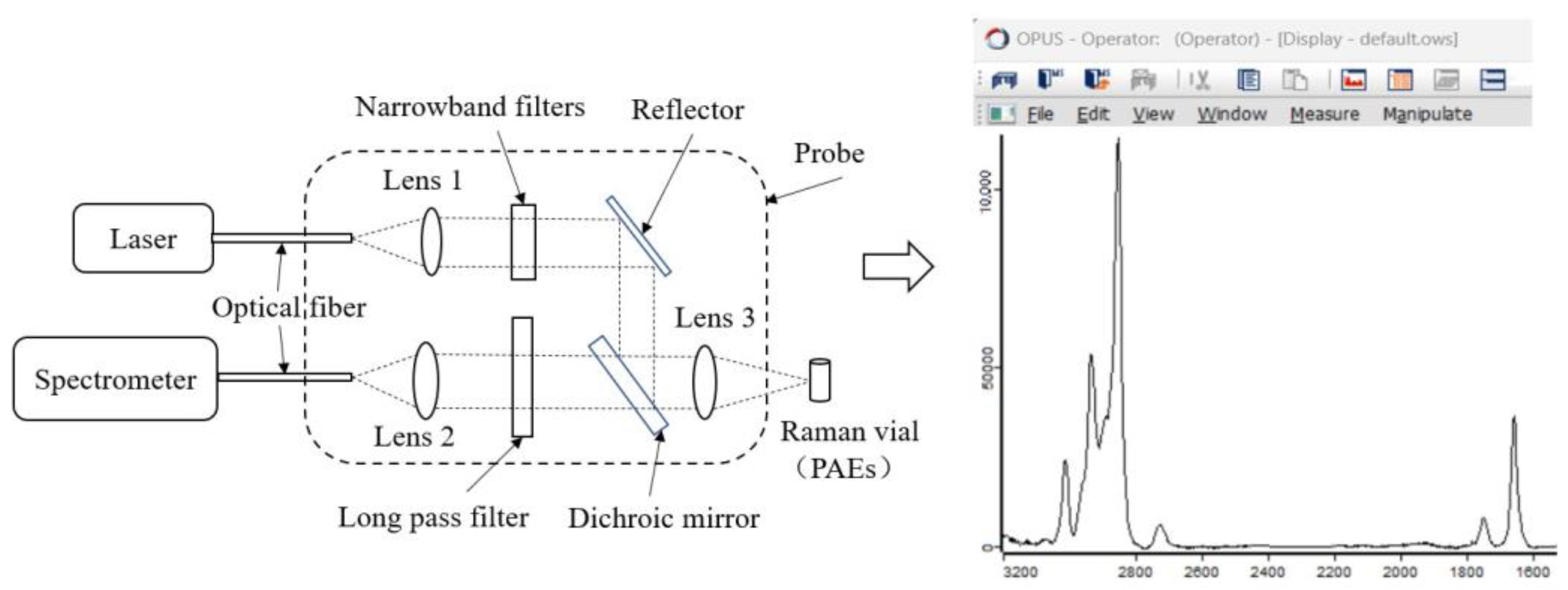
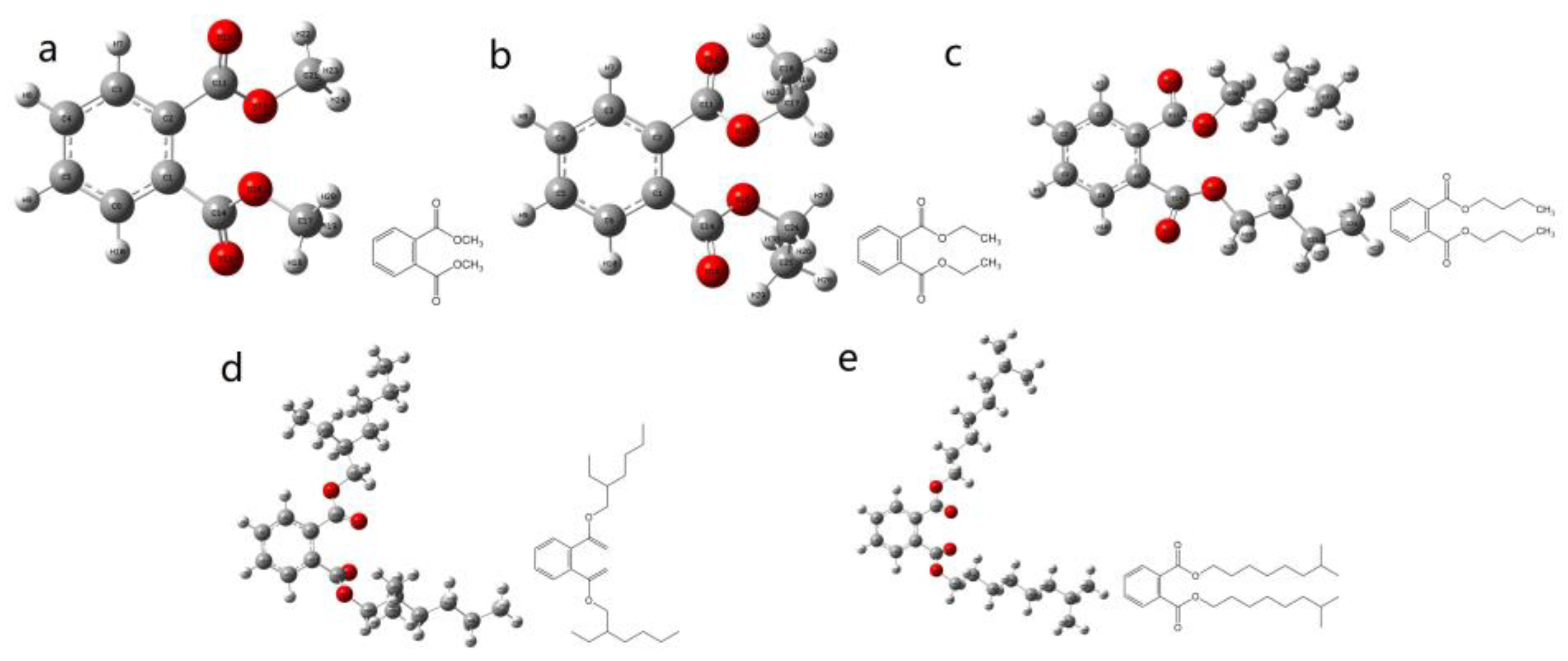
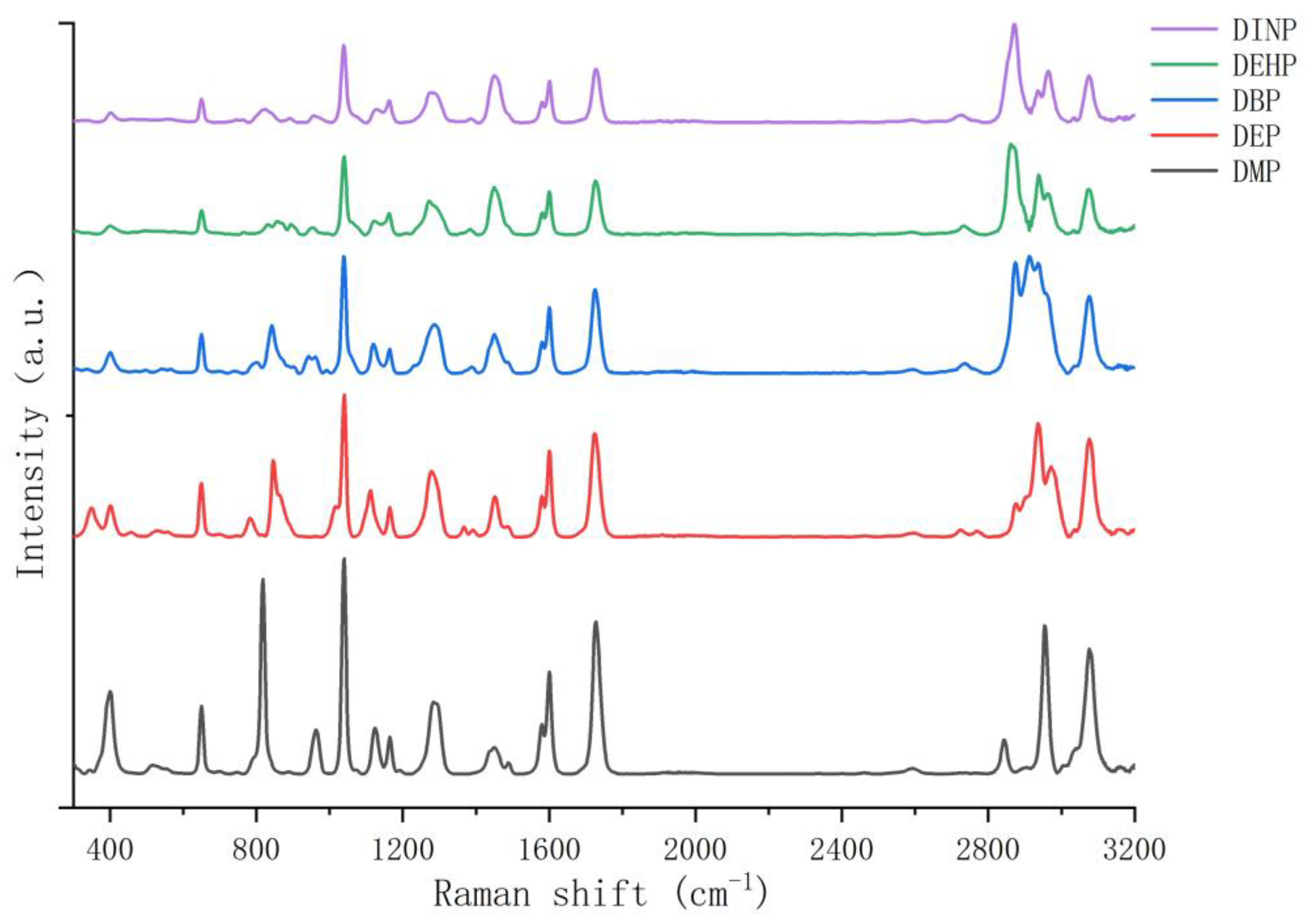
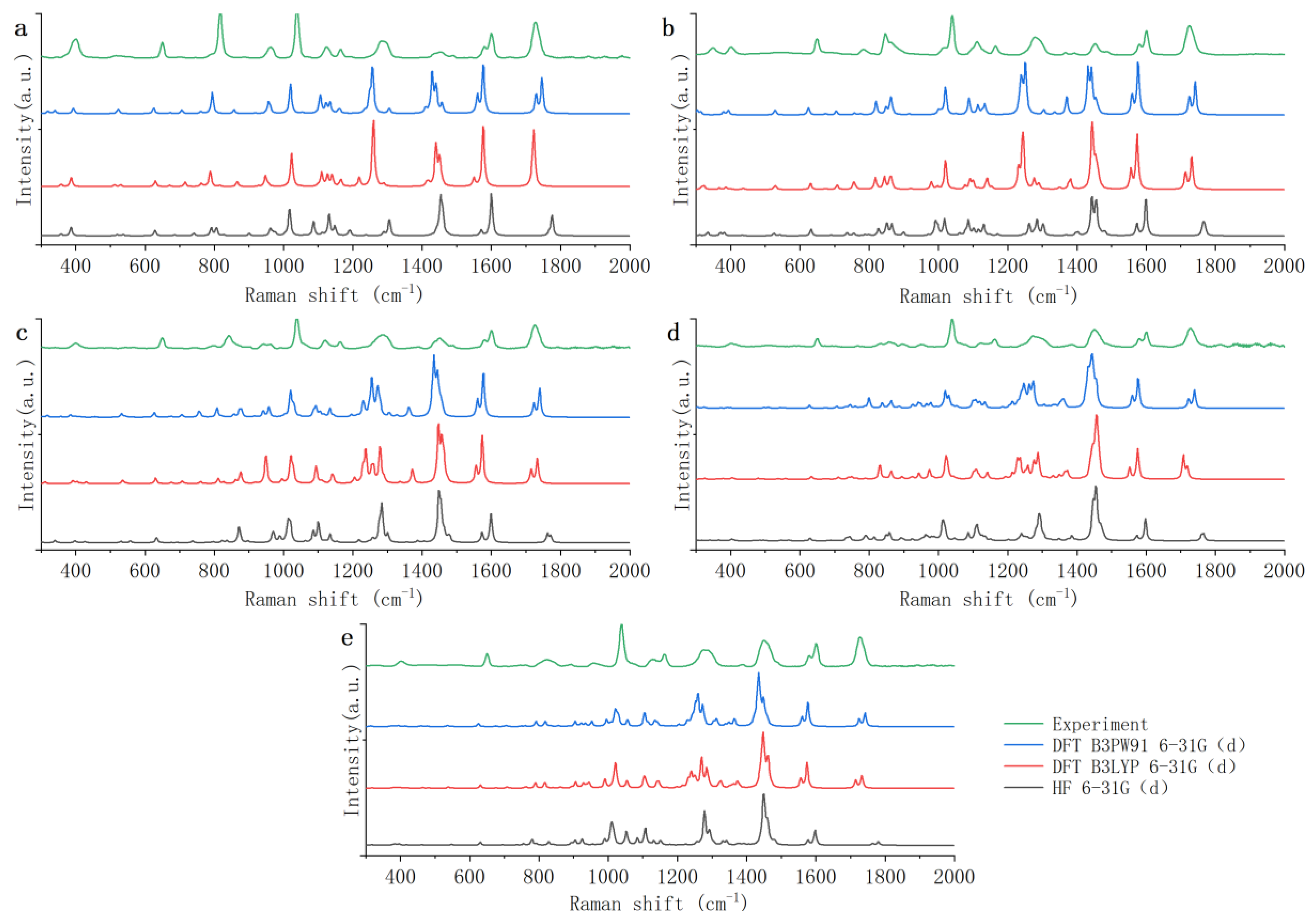
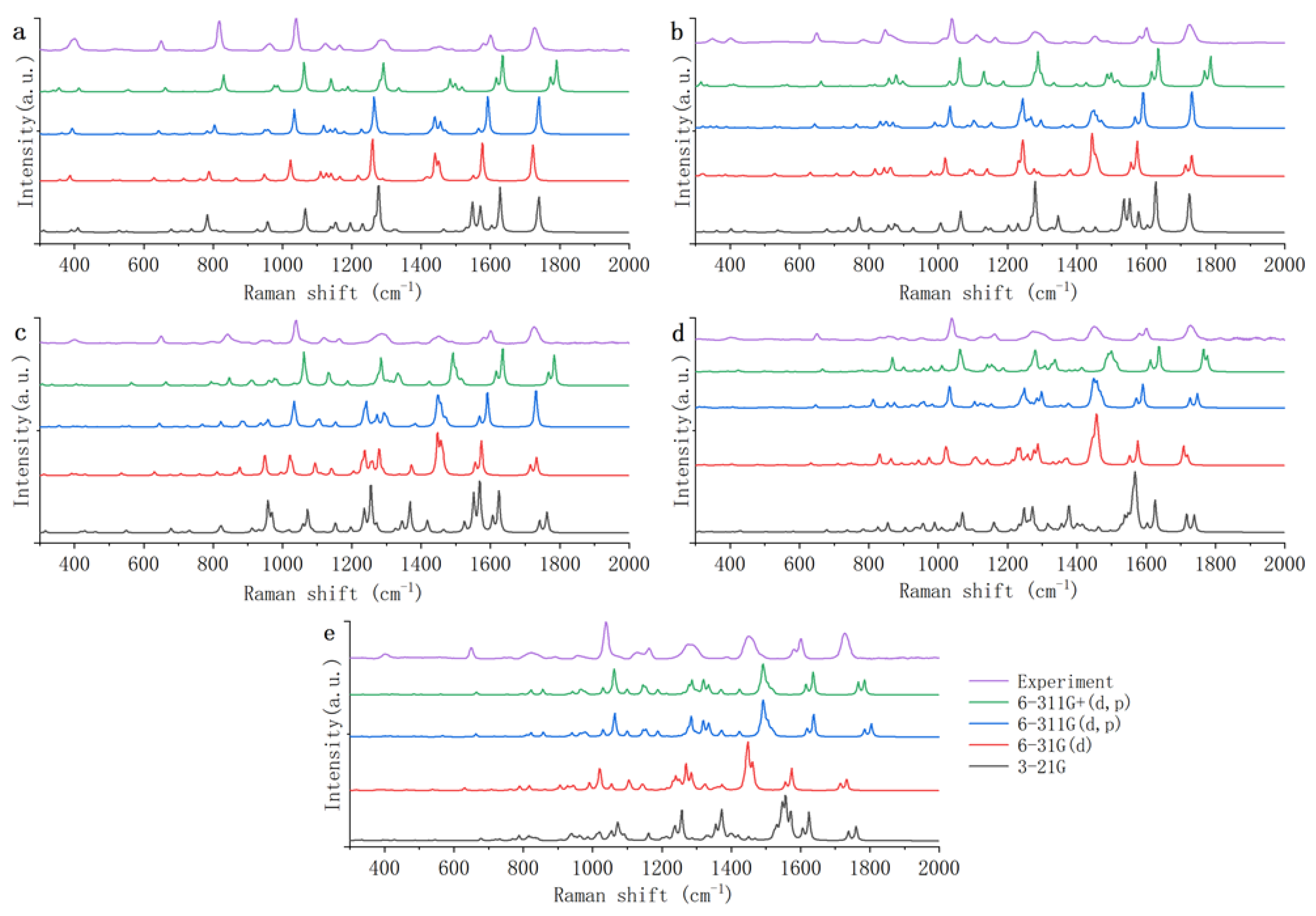
| Name | Abbreviations | Chemical Formula | Molecular Weight | Density (g/cm3) | Harm |
|---|---|---|---|---|---|
| Dimethyl phthalate | DMP | C10H10O4 | 194.19 | 1.18 | Suppression of the central nervous system |
| Diethyl phthalate | DEP | C12H14O4 | 222.24 | 1.12 | Headaches, dizziness, and vomiting |
| Dibutyl phthalate | DBP | C16H22O4 | 278.34 | 1.05 | Teratogenic effect on embryos |
| Di(2-ethyl)hexyl phthalate | DEHP | C24H38O4 | 390.56 | 0.99 | Carcinogenic to animals |
| Diisononyl phthalate | DINP | C26H42O4 | 418.61 | 0.97 | Some effects on reproduction, development, and cancer |
| Experimental (cm−1) | DFT B3LYP 6-311G(d, p) (cm−1) | ||||
|---|---|---|---|---|---|
| DMP | DEP | DBP | DEHP | DINP | |
| 400 | 392 | 390 | 356 | 384 | 400 |
| 650 | 642 | 646 | 646 | 646 | 664 |
| 1040 | 1034 | 1038 | 1032 | 1034 | 1064 |
| 1120 | 1118 | 1102 | 1106 | 1104 | 1102 |
| 1160 | 1140, 1152 | 1152 | 1152 | 1154 | 1145 |
| 1284 | 1264 | 1244, 1268 | 1242, 1272 | 1248, 1294 | 1284, 1320 |
| 1450 | 1440, 1456 | 1448 | 1448 | 1448 | 1538 |
| 1580 | 1564 | 1568 | 1568 | 1574 | 1620 |
| 1600 | 1592 | 1590 | 1592 | 1590 | 1636 |
| 1726 | 1740 | 1730 | 1732 | 1726, 1750 | 1786, 1800 |
| PAEs Type | Theoretical (cm−1) | Experimental (cm−1) | Assignments | Strength |
|---|---|---|---|---|
| DMP, DEP, DBP, DEHP and DINP | 390 | 400 | γ(C-C of the benzene ring) | m |
| 634 | 650 | β(Benzene) | s | |
| 1020 | 1040 | β(C-H of the benzene ring) | vs | |
| 1104 | 1120 | β(C-C-O) | m | |
| β(C-H of the benzene ring) | ||||
| 1152 | 1160 | β(C-H of the benzene ring) | s | |
| 1264 | 1284 | υ(C-C-O) | m | |
| γ(C-H) | w | |||
| β(C-H of the benzene ring) | s | |||
| 1438 | 1450 | γ(C-H) | m | |
| 1546 | 1580 | β(Benzene) | m | |
| 1570 | 1600 | β(Benzene) | s | |
| 1696 | 1726 | υ(C=O) | s | |
| γ(C-H) | w |
| PAEs Type | Theoretical (cm−1) | Experimental (cm−1) | Assignments | Strength |
|---|---|---|---|---|
| DMP | 802 | 818 | δ(O=C-O) | w |
| γ(C-H of the -CH3) | m | |||
| 960 | 964 | υ(O-CH3) | m | |
| γ(C-H of the benzene ring) | m | |||
| DEP | 360 | 352 | υ(C-H of -C2H5) | m |
| 764 | 784 | γ(C-H of -C2H5) | s | |
| 850 | 848 | β(O=C-O) | w | |
| γ(C-H of -C2H5) | m | |||
| DBP | 822 | 810 | β(O=C-O) | w |
| γ(C-H of -C4H9) | m | |||
| 882 | 842 | γ(C-H of -C4H9) | m | |
| 936 | 940 | υ(O-CH3) | s | |
| 958 | 962 | |||
| DEHP | 812 | 834 | β(O=C-O) | w |
| 824 | 858 | β(O=C-O) | m | |
| γ(C-H of -C2H3(C2H5)C4H9) | m | |||
| 874 | 894 | γ(C-H of -C2H3(C2H5)C4H9) | m | |
| 958 | 956 | υ(C-O-C) | m | |
| DINP | 822 | 822 | β(O=C-O) | m |
| 940 | 900 | γ(C-H of -C7H13(CH3)2) | m | |
| 978 | 960 | υ(C-O-C) | m |
Disclaimer/Publisher’s Note: The statements, opinions and data contained in all publications are solely those of the individual author(s) and contributor(s) and not of MDPI and/or the editor(s). MDPI and/or the editor(s) disclaim responsibility for any injury to people or property resulting from any ideas, methods, instructions or products referred to in the content. |
© 2023 by the authors. Licensee MDPI, Basel, Switzerland. This article is an open access article distributed under the terms and conditions of the Creative Commons Attribution (CC BY) license (https://creativecommons.org/licenses/by/4.0/).
Share and Cite
Sun, T.; Wang, Y.; Li, M.; Hu, D. Raman Spectroscopic Study of Five Typical Plasticizers Based on DFT and HF Theoretical Calculation. Foods 2023, 12, 2888. https://doi.org/10.3390/foods12152888
Sun T, Wang Y, Li M, Hu D. Raman Spectroscopic Study of Five Typical Plasticizers Based on DFT and HF Theoretical Calculation. Foods. 2023; 12(15):2888. https://doi.org/10.3390/foods12152888
Chicago/Turabian StyleSun, Tong, Yitao Wang, Mingyue Li, and Dong Hu. 2023. "Raman Spectroscopic Study of Five Typical Plasticizers Based on DFT and HF Theoretical Calculation" Foods 12, no. 15: 2888. https://doi.org/10.3390/foods12152888
APA StyleSun, T., Wang, Y., Li, M., & Hu, D. (2023). Raman Spectroscopic Study of Five Typical Plasticizers Based on DFT and HF Theoretical Calculation. Foods, 12(15), 2888. https://doi.org/10.3390/foods12152888








